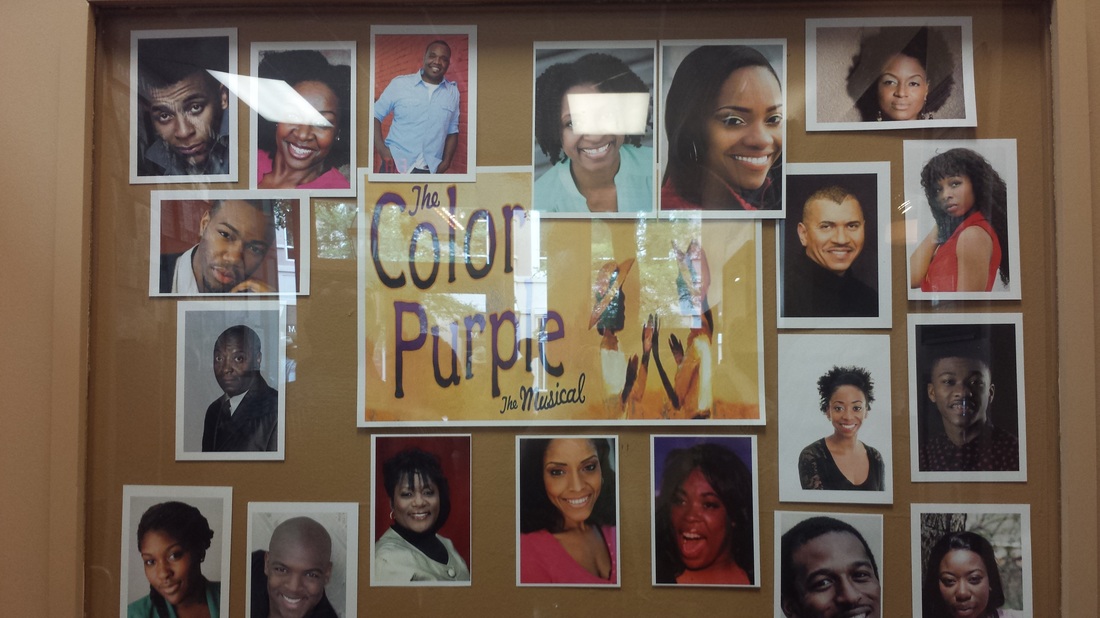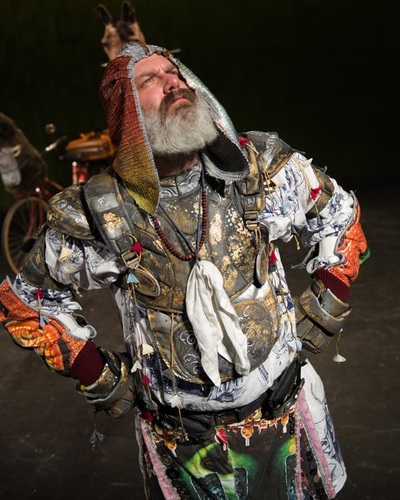The color Purple (the musical)The Color Purple started life as a novel by Alice Walker, then quickly became a movie directed by Steven Spielberg. I saw the movie when it came out in 1985, but had not ever seen the musical version, which premiered in 2005. I had to read the book in college for my Women Writers class and as is always the case with adaptations of novels, the movie left so much out. So here I am ten years later finally getting to see what had been done with the novel to turn it into the musical. The Jubilee production was directed by Akin Babatunde with musical direction by Geno Young and choreography by Shate Edwards. The Jubilee is a fairly small space so I went into it wondering how they were going to fit all those singers into that space. The scenic designer, Donna Marquet, provided a narrow platform at the back of the stage that tended to contain the chorus every time they would walk on to add their voices to the scene. The characters of Jarene, Darlene, and Doris functioned as a Greek chorus by commenting on the action in word or in song. The ladies that played those roles--Crystal Williams, Deon Sanders, and Liz Francisco-- had amazing voices. I wish I could sing like that. Jarene, Darlene, and Doris tended to stay in a clump over on stage right. The lead characters made center stage their home base and minimized traffic flow issues in this manner. The set was painted in shades of white as were the costumes. Everyone looked completely angelic, even awful Old Mister and Mr. Albert. One really neat technical element that I want to mention is the scene where Shug is given a bath by Celie. I wondered how they were going to do that on stage. A clawfoot tub was rolled out on a platform filled with fine white tulle (netting). The lights went dark, Celie helped Shug out of her clothes and into a bathrobe in silhouette, and then led her over to the tub and disrobed her and helped her get in. By the time the lights came back up, Shug (Junene K.) was safely in the tub covered by the wadded up yards of tulle and not showing anything she shouldn't. The tulle perfectly mimicked soap bubbles; it was so clever. Because I was familiar with the story and knew how things were going to play out for these characters I thought that I would be immune to the sadness of Celie's journey. I was wrong. The acting chops and the vocal dynamite that this company brought to their roles was so overwhelming that I spent most of the show laughing through my tears. I don't know why adding music to the story makes it so much sadder, but it does. I would like to specifically point out Calvin Scott Roberts, who's performance as Mr. Albert was phenomenal. He does have a change of heart at the end and even though it's too little too late for his marriage to Celie, his redemption is still powerful. Celie (Ebony Marshall Oliver) has an amazing transformation on stage, partially to the credit of the costume designer, Barbara O'Donoghue, who dresses her in dark colors at the beginning and then as her story progresses, gives her lighter and lighter shades of purple to wear. However, most of the credit goes to Oliver as her acting makes us believe that she is a child playing with her sister, and then she takes us on the journey of her struggle for empowerment, her role model in Sophia, her loving relationship with Shug, her cursing Mr. Albert and leaving him to go out on her own, and finally her forgiveness of him and her reunion with her sister and children. By the end of the play she is tranformed from an ugly powerless child into a beautiful and powerful woman. It was an incredible thing to witness. I hope that you got a chance to see it, since it was sold out the entire run by the time we went. And of course, McLennan alum Whitney Coulter was fabulous singing and dancing in the chorus as well as playing Olivia, Celie's daughter. We picked up the 2015-16 Season brochure on our way out and can't wait to see more shows there. Two tickets: $56.76. The Quixotic days and errant nights of the errant knight Don QuixoteThe Quixotic Days and Errant Nights of the Knight Errant Don Quixote was a world premiere. This was not at all the musical Man of La Mancha that we are all used to seeing. This is a completely new adaption of the source material. From the program notes the playwright Brenda Winters says, "It is helpful, I think, when attempting to transform a 900-page masterpiece into a significantly less-than 900 page play, if the masterpiece in question is riddled with reminders that impossible dreams are wroth dreaming. Those familiar with Cervantes' original The Ingenious Gentleman Don Quixote of La Mancha know how richly layered each installment of this long and winding tale really is and can understand how vexing it might be to determine which immaculate parts might best represent the magnificent whole. When allowed just a taste of the perfect apple, where does one take the first bite? I approached this adaptation ....with an open mind and ready heart. I read and reread the novel in voracious bursts, then let the stories settle to see which left the deepest, most enduring marks; these were the episodes I focused on exploring and including in the piece you'll see tonight....As an admirer and grateful beneficiary of Cervantes' unmatched wisdom, I hope this adaptation will do two things: deliver Don Quixote's essential themes of idealism, independence, and integrity to a wide, delighted audience, and inspire that same audience to return to the source for further discovery. Any tree that produces fruit this juicy is worth sitting under for awhile." As the audience comes into the theatre to be seated, the playing space is separated from the house by a clear, plastic curtain. We are looking into a modern day bedroom that has been augmented with hospital equipment and the person that I presumed to be Don Quixote, is lying in the hospital bed apparently asleep. Surrounded by an IV and other hospital equipment, he seems to be in a coma. The sound design gave us the beeping of machines, his breathing, his heartbeat, all echoed and haunting and sad. As the action of the play begins, we can see the actors coming on and off but the curtain mutes the sound of the dialogue (or in reality, the actors weren't making any sounds.) Don Alonso's family comes in, tearful, mournful, clearly upset that their loved one is dying. The doctor comes in to check on him and talk with his niece. A priest is brought for his last rites. The niece gets on the small bed with him and hugs him one last time. The housekeeper hugs the niece. All of this action goes on with the constant hospital noises echoing through the space, but the dialogue is in complete silence, This goes on for a good 15 minutes. It looks like the end is near. Machines are turned off, the noises fade, his face is covered with the sheet. The audience is already wondering if the rest of the play is going to be a flashback, when suddenly, Don Alonso sits up in bed, opens his eyes, and speaks! It's a miracle! Except abruptly now all of the other characters are MAD. The actors rip down the plastic sheet dividing the audience from the action. The dialogue is abruptly audible now. Don Alonso goes offstage in his hospital gown to begin dressing while the niece and the housekeeper begin piling up all of his books at the front of the stage. There's going to be a bonfire. It was the books that caused his madness. If they destroy the books, they will bring back his sanity. Once a sufficient number of books have been piled up, the lighter is brought to ignite the fuel and Whoosh! (another great sound effect) a projection of bonfire is thrown against the white walls of the bedroom with all the crackle of burning books sound effects you'd expect. It was both magnificent and scary. I found out later, from Christy Vela who plays the Housekeeper and Dulcinea, that all of the hospital stuff at the beginning was not in the script. The director added all of that. I thought it was an amazing idea and I was surprised how intensely my interest was held even and especially when I couldn't hear what the actors were saying. The other brilliant thing about this show was the costume design by Laura Barbata. You can see some in process stuff from her in this photo below. She had the idea to design textiles for the show and had the words from the novel printed onto the fabric that Dulcinea's dress was made from. Don Quixote's costume was a textile design project as well. His costume was designed to appear raggedy as if it had been pieced together from many different garments. There was so much going on in that one costume. As an audience member I found myself studying the costumes (we were sitting on the front row so I actually did get lots of opportunities to see them up close and personal) and not paying attention to the play, that's how interesting they were. In Act II, the household members disguise themselves as maidens in distress as a way to capture Don Alonso and bring him back home. Their disguises were also hand printed textiles that featured more words and symbols from the script. If you click on the last photo in the gallery you can see them. The only problem that I had with this play is that the ending is weak. The household members decide, led to that decision by the housekeeper, that Don Alonso is better off in his dream of being Don Quixote and that they need to release him from the cage and let him ride off into the sunset, which he does, while Dulcinea is singing. In a movie that works wonderfully--roll credits and go home--but in a play, it left me wanting an end that actually ends. But honestly, if that's my only complaint, then you know it was a great piece of theatre. Very moving. I hope it gets picked up and theatres all over the country start doing it. We got Industry tickets: two tickets $36.
0 Comments
Leave a Reply. |
CategoriesArchives
July 2024
|
























 RSS Feed
RSS Feed